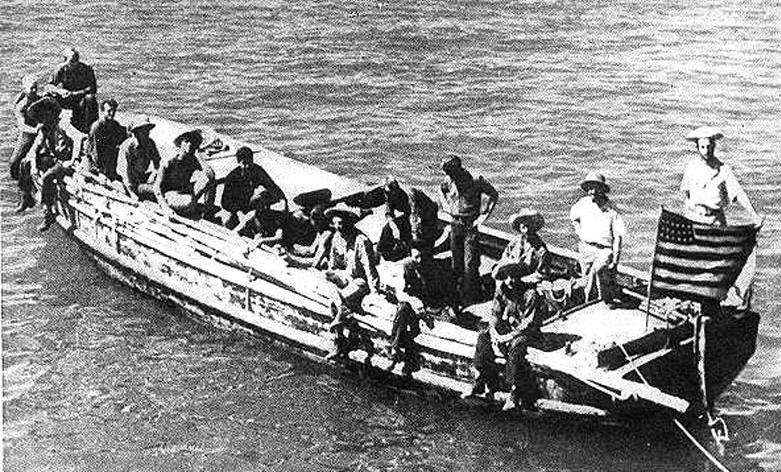
No, not quite - the results of one of the greatest examples of Navy leadership and seamanship. Then LCDR John Morrill II (later RADM) took the balance of his crew from the just scuttled USS Quail (AM-15) and took them 1,900nm in a 36' motor launch from The Philippines to Darwin, Australia. They left on the day,
And stealing some more from Sid,In the pre-dawn hours on Corregidor, Japanese troops push towards the Malinta Tunnel, against fierce but uncoordinated opposition. The Americans have more than 15,000 men on Corregidor, 5,000 of them paperchasers in the Malinta Tunnel, but very few fighters, so they cannot organize a major counterattack. The Japanese are frustrated, too, having lost two-thirds of their landing craft. The Japanese have 21 boats to move 14,000 men. General Homma is thrown into an "agony of mind" by American ferocity.
But by dawn, the battle reaches its climax at Water Tank Hill, as O and P companies of 4th Marines counterattack, backed by the few remaining guns, which are now manned by cooks, clerks, and radiomen. US Navy Lt. Charles Brook, who has wondered since boyhood what it would be like to charge an enemy, gets his dream, but also gets a leg mangled by a grenade. By 9 am, the Americans are bogged down, as Japanese artillery takes over. By 10, the Japanese finally unload tanks on their beach. The Japanese now can drive into the Malinta Tunnel and massacre the nurses and wounded.
The Americans have no antitank weapons. Corregidor is finished...there are no reserves, no guns left, and Wainwright has a message from President Roosevelt saying that Wainwright "and your devoted followers have become the living symbols of our war aims and the guarantee of victory."
Wainwright gives the codeword "Pontiac" ordering his men to destroy their weapons and raise white flags. Col. Howard will become the first officer to ever surrender a US Marine Regiment. All across the island, US troops destroy their weapons or raid the remaining food and liquor stocks.
The Japanese send word that they will only deal with Wainwright. With his aide, Maj. Tom Dooley, Wainwright drives to Water Tank Hill and climbs on foot to the Japanese positions, noting that there are three Japanese dead for every American. The Japanese take Wainwright by launch to Cabcaben in Bataan. Homma arrives in a shiny Cadillac and in perfect English demands Wainwright surrender all the Philippines. Wainwright refuses. Homma says he will send Wainwright back to Bataan to "do what you damn well please," and continue fighting. The exhausted Wainwright draws up a surrender of the entire archipelago, and signs it just before midnight. The Japanese take the exhausted Wainwright back to Corregidor, and he flings himself on his cot, exhausted, reviewing the bitterest and most humiliating day of his life.
The channel through Corregidor's northern mine fields, through which boats must pass to meet rescue submarines, could no longer be used because of the Jap gun batteries now lining the shores of Bataan. There had never been a channel through the southern mine fields, which made it look as if we were bottled up by our own deadly obstructions.Fullbore.
There were mine sweepers among the Navy ships huddled in Corregidor's South Harbor, but no one had ever devised a sweep wire that could be pushed ahead of the ship, and if it were towed astern in the usual manner, the sweeping vessel would inevitably be blown up by the thickly planted mines. There was only one glimmer of hope. If small boats, starting close inshore, could sweep a narrow channel without chancing on mines near the surface, the big sweepers could follow behind and widen the breach -- provided they were lucky enough not to stray a few feet off the straight and narrow path. All this work would have to be done at night, making accurate navigation almost impossible.
No matter how dangerous the job, there were always enthusiastic navy men to undertake it. The versatile motor launches of the Canopus were turned over to experienced Mine Force sailors, and became miniature sweepers. Navigational lights were rigged on shore, hooded to screen their purpose from watchful Japanese eyes. Night after night, for two weeks, the daring crews gambled their lives against their skill -- and luck -- until success finally crowned their efforts. Many mines had exploded near venturesome boats, but never quite close enough to destroy them. Again a path to the sea was open, making it possible for submarines to come in and rescue a few chosen passengers.
Capt. E.L. Sackett C.O. U.S.S. Canopus
Indeed, earlier during the day of her scuttling, the Quail had made a daylight 600 yard sweep-while under fire-to permit an evacuation to the Spearfish. The crew-or more accurately the third left aboard as the majority were ashore at Corregidor in "IA" status-didn't get to go.









No comments:
Post a Comment